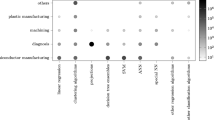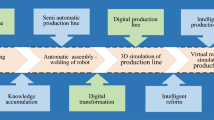Abstract
To enhance the level of precast production management, and to reduce the costs of precast production, a lean precast production system is developed based on the constant work-in-process (CONWIP) method. Then the performance of this system is verified using the Discrete Event Simulation (DES). A quantitative performance evaluation between the lean precast production system and the current precast production process is provided using the JaamSim simulation platform. Cases and site visits to precast concrete plant in China are combined to collect the production procedures and initial parameters involved in precast production. Through simulations, Non-value Adding (NVA) activities, as well as bottleneck workstations, are identified in precast production. The optimal number of cards to be used in the lean precast production system is also presented. Our simulation experiments show that the lean precast production system provides an effective way to control queue length and shorten the WIP and cycle time, while also maintaining throughput and saving 25.4% of labour cost.
Similar content being viewed by others
References
Ajorlou, S., Shams, I., and Aryanezhad, M. G. (2011). “A genetic algorithm approach for multi-product multi-machine CONWIP production system.” Applied Mechanics and Materials, pp. 110–116, pp. 3624–3630, DOI: 10.4028/www.scientific.net/AMM.110-116.3624.
Azam Haron, N., Abdul-Rahman, H., Wang, C., and Wood, L. C. (2015). “Quality function deployment modelling to enhance industrialised building system adoption in housing projects.” Total Quality Management & Business Excellence, vol. 26, Nos. 7–8, pp. 703–718, DOI: 10.1080/14783363.2014.880626.
Benjaoran, V., Dawood, N., and Hobbs, B. (2005). “Flowshop scheduling model for bespoke precast concrete production planning.” Construction Management and Economics, vol. 23, no. 1, pp. 93–105, DOI: 10.1080/0144619042000287732.
Braglia, M., Frosolini, M., Gabbrielli, R., and Zammori, F. (2011). “CONWIP card setting in a flow-shop system with a batch production machine.” International Journal of Industrial Engineering Computations, vol. 2, no. 1, pp. 1–18, DOI: 10.5267/j.ijiec.2010. 07.004.
Chan, W.-H. and Lu, M. (2008). “Materials handling system simulation in precast viaduct construction: Modeling, analysis, and Implementation.” Journal of Construction Engineering and Management, Vol. 134, No. April, pp. 300–310, DOI: 10.1061/(ASCE)0733-9364(2008) 134:4(300).
Chen, J.-H. H., Yang, L.-R. R., and Tai, H.-W. W. (2016). “Process reengineering and improvement for building precast production.” Automation in Construction, vol. 68, pp. 249–258, DOI: 10.1016/j.autcon.2016.05.015.
Cochran, J. K. and Kaylani, H. A. (2008). “Optimal design of a hybrid push/pull serial manufacturing system with multiple part types.” International Journal of Production Research, vol. 46, no. 4, pp. 949–965, DOI: 10.1080/00207540600905547.
Gallardo, C., Granja, A., and Picchi, F. (2014). “Productivity gains in a line flow precast concrete process after a basic stability effort.” Journal of Construction Engineering and Management, Vol. 140, No. 4, B4013004-1-8, DOI: 10.1061/(ASCE)CO.1943-7862.0000728.
Harrison, H. S. and Street, H. (2013). “Open source simulation Software ‘JAAMSIM’.” Proceedings-Winter Simulation Conference, pp. 2163–2171, DOI: 10.1109/WSC.2013.6721593.
Hopp, W. J. and Spearman, M. L. (1996). Factory physics. Business Logistics. Chicago: Irwin.
Jahangirian, M., Eldabi, T., Naseer, A., Stergioulas, L. K., and Young, T. (2010). “Simulation in manufacturing and business: A review.” European Journal of Operational Research, vol. 203, no. 1, pp. 1–13, DOI: 10.1016/j.ejor.2009.06.004.
Jain, S. and Foley, W. J. (2016). “Dispatching strategies for managing uncertainties in automated manufacturing systems.” European Journal of Operational Research, vol. 248, no. 1, pp. 328–341, DOI: 10.1016/j.ejor.2015.06.060.
Khalili, a. and Chua, D. K. (2014). “Integrated prefabrication configuration and component grouping for resource optimization of precast production.” Journal of Construction Engineering and Management, Vol. 140, No. 2, 4013052, DOI: 10.1061/(ASCE)CO.1943-7862. 0000798.
Ko, C.-H. and Wang, S.-F. (2011). “Precast production scheduling using multi-objective genetic algorithms.” Expert Systems with Applications, vol. 38, no. 7, pp. 8293–8302, DOI: 10.1016/j.eswa.2011.01.013.
Ko, C. H. and Wang, S. F. (2010). “GA-based decision support systems for precast production planning.” Automation in Construction, vol. 19, no. 7, pp. 907–916, DOI: 10.1016/j.autcon.2010.06.004.
Ko, C. and Wang, S. (2013). Arranging precast production schedules using genetic algorithms, (Eppm), 784–794.
Korugan, A. and Gupta, S. M. (2014). “An adaptive CONWIP mechanism for hybrid production systems.” International Journal of Advanced Manufacturing Technology, vol. 74, Nos. 5–8, pp. 715–727, DOI: 10.1007/s00170-014-5977-2.
Koskela, L. (2000). “An exploration towards a production theory and its application to construction.” D. Tech thesis, Helsinki University of Technology, Espoo, 296, available at http://www.inf.vtt.fi/pdf/publications/2000/P408.pdf.
Koulouriotis, D. E., Xanthopoulos, A. S., and Tourassis, V. D. (2010). “Simulation optimisation of pull control policies for serial manufacturing lines and assembly manufacturing systems using genetic algorithms.” International Journal of Production Research, vol. 48, no. 10, pp. 2887–2912, DOI: 10.1080/00207540802603759.
Lu, W., Olofsson, T., and Segerstedt, A. (2010). “Application of discrete event simulation and conwip on inventory control.” (1999), pp. 16–18.
Najafi, A. L. I. and Tiong, R. (2015). Simulation as a Tool for Productivity Modeling of Precast Concrete Installation, vol. 10, no. 1, pp. 1–7.
Nath, T., Attarzadeh, M., Tiong, R. L. K., Chidambaram, C., & Yu, Z. (2015). “Productivity improvement of precast shop drawings generation through BIM-based process re-engineering.” Automation in Construction, vol. 54, pp. 54–68, DOI: 10.1016/j.autcon.2015.03.014.
Nawi, M., Lee, A., and Nor, K. (2011). “Barriers to implementation of the Industrialised Building System (IBS) in Malaysia.” The Built & Human Environment Review, Vol. 4(November), pp. 22–35, http://tbher.org/index.php/tbher/article/view/64.
Nazarian, E. and Ko, J. (2013). “Robust manufacturing line design with controlled moderate robustness in bottleneck buffer time to manage stochastic inter-task times.” Journal of Manufacturing Systems, vol. 32, no. 2, pp. 382–391, DOI: 10.1016/j.jmsy.2012.12.005.
Nelson, B. L. and Matejcik, F. J. (1995). “Using common random numbers for indifference-zone selection and multiple comparisons in simulation.” Management Science, vol. 41, no. 12, pp. 1935–1945, DOI: 10.1287/mnsc.41.12.1935.
Pan, W., Gibb, A. G. F., and Dainty, A. R. J. (2007). “Perspectives of UK housebuilders on the use of offsite modern methods of construction.” Construction Management and Economics, vol. 25, no. 2, pp. 183–194, DOI: 10.1080/01446190600827058.
Pedrielli, G., Alfieri, A., and Matta, A. (2015). “Integrated simulation–optimisation of pull control systems.” International Journal of Production Research, Vol. 7543, (February 2015), pp. 1–20, DOI: 10.1080/00207543.2014.997404.
Prakash, J. and Chin, J. F. (2014). Modified CONWIP systems: A review and classification.” Production Planning & Control: The Management of Operations, Vol. 7287, (March), pp. 1–12, DOI: 10.1080/09537287.2014.898345.
Renna, P., Magrino, L., and Zaffina, R. (2013). “Dynamic card control strategy in pull manufacturing systems.” International Journal of Computer Integrated Manufacturing, vol. 26, no. 9, pp. 881–894, DOI: 10.1080/0951192X.2013.799783.
Spearman, M. L., Woodruff, D. L., and Hopp, W. J. (1990).“ CONWIP, a pull alternative to kanban.” International Journal of Production Research, DOI: 10.1080/00207549008942761.
Tommelein, I. D. (2015). “Journey toward Lean Construction: Pursuing a Paradigm Shift in the AEC Industry.” Journal of Construction Engineering and Management, vol. 141, no. 1970, pp. 1–12, DOI: 10.1061/(ASCE)CO.1943-7862.0000926.
Wang, C., Liu, M., Asce, A. M., Hsiang, S. M., Leming, M. L., and Asce, M. (2013). “Causes and penalties of variation: case study of a precast concrete slab production facility.” Journal of Construction Engineering and Management, Vol. 138, March, pp. 1–12, DOI: 10.1061/(ASCE)CO.1943-7862.
Wu, P., Low, S. P., and Jin, X. (2013). “Identification of Non-value Adding (NVA) activities in precast concrete installation sites to achieve low-carbon installation.” Resources, Conservation and Recycling, Vol. 81, November, pp. 60–70, DOI: 10.1016/j.resconrec. 2013.09.013.
Xanthopoulos, A. S. and Koulouriotis, D. E. (2014). “Multi-objective optimization of production control mechanisms for multi-stage serial manufacturing-inventory systems.” International Journal of Advanced Manufacturing Technology, vol. 74, Nos. 9–12, pp. 1507–1519, DOI: 10.1007/s00170-014-6052-8.
Zabihi, H., Habib, F., and Mirsaeedie, L. (2013). “Definitions, concepts and new directions in Industrialized Building Systems (IBS).” KSCE Journal of Civil Engineering, vol. 17, no. 6, pp. 1199–1205, DOI: 10.1007/s12205-013-0020-y.
Zhai, X., Tiong, R. L. K., Bjornsson, H. C., and Chua, D. K. H. (2008). “Simulation-based planning for precast production with two critical resources.” Proceedings-Winter Simulation Conference, (1996), pp. 2519–2526, DOI: 10.1109/WSC.2008.4736362.
Zhang, X., Skitmore, M., and Peng, Y. (2014). “Exploring the challenges to industrialized residential building in China.” Habitat International, vol. 41, pp. 176–184, DOI: 10.1016/j.habitatint.2013.08.005.
Author information
Authors and Affiliations
Corresponding author
Rights and permissions
About this article
Cite this article
Li, X., Li, Z. & Wu, G. Lean Precast Production System based on the CONWIP Method. KSCE J Civ Eng 22, 2167–2177 (2018). https://doi.org/10.1007/s12205-017-2009-4
Received:
Revised:
Accepted:
Published:
Issue Date:
DOI: https://doi.org/10.1007/s12205-017-2009-4




